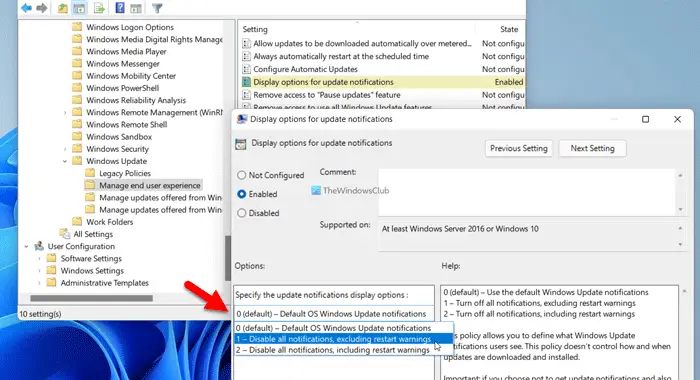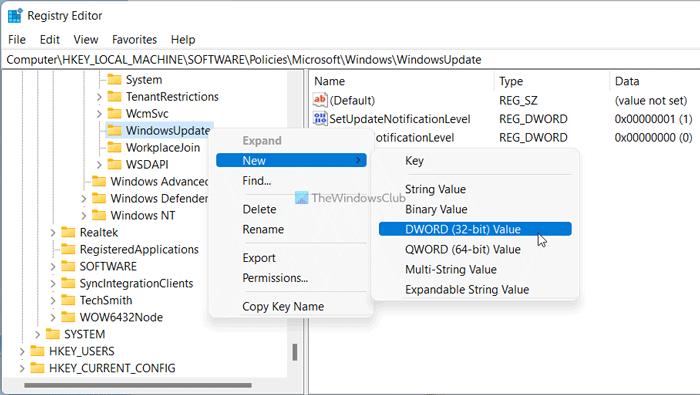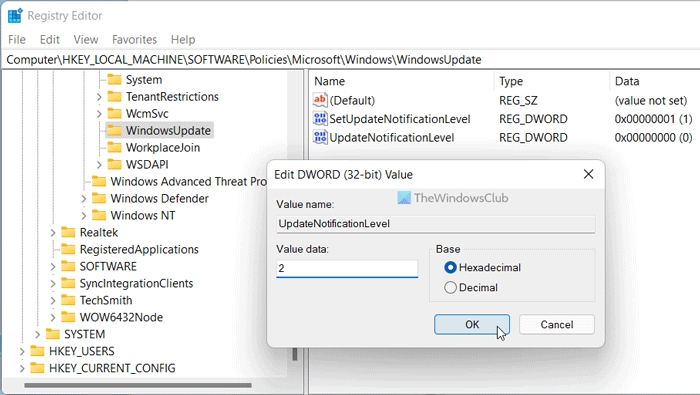You can show or hide the Display options for Update notifications on your Windows 11 computer using Group Policy Editor or Registry Editor. This article explains both methods, and you can follow them according to your Windows 11 version (Home, Pro, etc.).
Windows 11 displays mainly two types of notifications when it is required to install an update:
- One which notifies that you have an update ready to be installed.
- Another one notifies you that you have to restart your computer to complete the installation.
If you do not want to get such notifications every now and then, this guide will help you get rid of them.
Show or hide Display options for Update notifications in Windows 11
To show or hide display options for Update notifications in Windows 11, follow these steps:
- Press Win+R to open the Run prompt.
- Type gpedit.msc and hit the Enter button.
- Navigate to Manage end user experience in Computer Configuration.
- Double-click on the Display options for update notifications setting.
- Choose the Enabled option.
- Choose a display option from the drop-down list.
- Click the OK button.
To learn more about these steps, continue reading.
First, you need to open the Local Group Policy Editor on your computer. For that, press Win+R to open the Run prompt, type gpedit.msc, and hit the Enter button.
Once it is opened on your screen, you need to navigate to this path:
Computer Configuration > Administrative Templates > Windows Components > Windows Update > Manage end-user experience
Here you can find a setting named Display options for update notifications. You need to double-click on this setting and choose the Enabled option.

Next, you have three options to choose:
- Default OS Windows Update notifications
- Disable all notifications, excluding restart warnings
- Disable all notifications, including restart warnings
Once the selection is made, click the OK button to save the change.
Turn On or Off Display options for Update notifications in Windows 11 using Registry
To Show or hide display options for Update notifications in Windows 11 using Registry, follow these steps:
- Press Win+R to get the Run prompt.
- Type regedit > click the OK button > click the Yes button.
- Navigate to Windows in HKLM.
- Right-click on Windows > New > Key and name it as WindowsUpdate.
- Right-click on WindowsUpdate > New > DWORD (32-bit) Value.
- Set the name as SetUpdateNotificationLevel.
- Double-click on it to set the Value data as 1.
- Click the OK button.
- Create another REG_DWORD value and name it as UpdateNotificationLevel.
- Double-click on it to set the Value data as 0, 1, or 2.
- Click the OK button.
- Restart your computer.
Let’s check out these steps in detail.
First, you need to open the Registry Editor. For that, press Win+R > type regedit > click the OK button > click on the Yes button on the UAC prompt.
Then, navigate to this path:
HKEY_LOCAL_MACHINE\SOFTWARE\Policies\Microsoft\Windows
Right-click on Windows > New > Key and name it as WindowsUpdate.
Next, right-click on WindowsUpdate > New > DWORD (32-bit) value and set the name as SetUpdateNotificationLevel. Double-click on it to set the Value data as 1.

Click the OK button. Following that, create another DWORD (32-bit) Value and name it as UpdateNotificationLevel. Double-click on it to set the Value data as follows:
- 0: Default OS Windows Update notifications
- 1: Disable all notifications, excluding restart warnings
- 2: Disable all notifications, including restart warnings

Click the OK button and restart your computer.
How do I hide Windows Update notifications?
To hide Windows Update notifications, you can follow the aforementioned guides. It is possible to show or hide the Update notifications with the help of the Local Group Policy Editor and the Registry Editor. In the GPEDIT, you need to open the Display options for update notifications setting and choose the desired option.
How do I get rid of the Windows 11 Update notification?
To get rid of the Windows 11 Update notification, you can follow the Registry method mentioned above. In the Registry Editor, you need to create two REG_DWORD values named SetUpdateNotificationLevel and UpdateNotificationLevel. Then, set the Value data of SetUpdateNotificationLevel as 1 and UpdateNotificationLevel as 0, 1, or 2.
That’s all! Hope this guide helped.
Read: Recommended Windows Update policies Admins should be using.
Leave a Reply